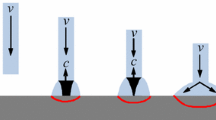Abstract
We consider the process of fracture of a solid celestial body with a certain strength entering a planetary atmosphere. Using an integral approach in fracture mechanics, we show that the process of fragmentation of a meteorite occurs in several stages and is completed when the maximum value of the aerodynamic drag is reached. The characteristic size of the fragments formed depends on the properties of the meteorite material. At the end of fragmentation, the stage of rapid deceleration of the fragments begins: “pumping” the energy of the meteorite into a shock wave. The proposed technique is illustrated using the examples of the interaction of the Tunguska meteorite with the Earth's atmosphere and the interaction of Comet Shoemaker—Levy with Jupiter's atmosphere.
Similar content being viewed by others
References
S. S. Grigoryan, “The nature of the Tunguska meteorite,” Dokl. Akad. Nauk SSSR,231, No. 1, 57–60 (1976).
I. T. Zotkin and M. A. Tsykulin, ”Modeling the explosion of the Tunguska meteorite,” Dokl. Akad. Nauk SSSR,167, No. 1, 59–62 (1966).
V. P. Korobeinikov, P. I. Chushkin, and L. V. Shurshalov, “Zone of ground devastation upon explosion of a large meteorite in the air,” Izv. Akad. Nauk SSSR, Mekh. Zhidk. Gaza, No. 3, 94–100 (1974).
B. V. Voitsekhovskii, “The problem of the Tunguska meteorite,” Fiz. Goren. Vzryva,16, No. 5, 5–8 (1980).
G. P. Cherepanov, Mechanics of Brittle Fracture [in Russian], Nauka, Moscow (1974).
W. F. Weeks and A. Assur, “Fracture of lake and sea ice,” in: Fracture. Vol. 7, Pt. 1 [Russian translation], Mir, Moscow (1976), pp. 513–623.
A. G. Ivanov, “Dynamic fracture and scaling effects (review),” Prikl. Mekh. Tekh. Fiz., No. 3, 116–131 (1994).
A. G. Ivanov, “Role of inertial and elastic forces in dynamic fracture in the plastic region,” Dokl. Akad. Nauk SSSR,321, No. 1, 28–32 (1991).
Yu. I. Fadeenko, “Fracture of meteoric bodies in the atmosphere,” Fiz. Goren. Vzryva,3, No. 2, 278–280 (1967).
B. A. Ivanov, “Advances in the mechanics of crater formation,” in: Mechanics. New Developments in Foreign Science. No. 26: Shock, Explosion, and Fracture [Russian translation], Mir, Moscow (1981), p. 204.
Additional information
All-Union Scientific Research Institute of Experimental Physics, Sarov 607200. Translated from Fizika Goreniya i Vzryva, Vol. 31, No. 6, pp. 117–124, November–December, 1995.
Rights and permissions
About this article
Cite this article
Ivanov, A.G., Ryzhanskii, V.A. Possible nature of the explosion of the Tunguska meteorite and the breakup of the Comet Shoemaker-Levy. Combust Explos Shock Waves 31, 715–721 (1995). https://doi.org/10.1007/BF00744979
Received:
Issue Date:
DOI: https://doi.org/10.1007/BF00744979




